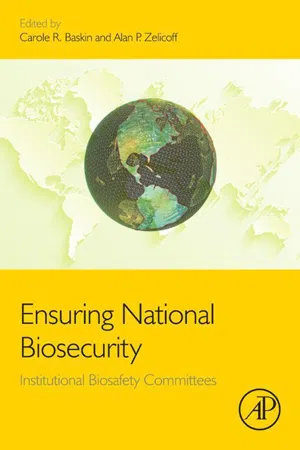Introduction
The term “biosecurity” is used in a wide variety of contexts and carries with it an equally diverse set of meanings. For example, veterinarians traditionally view biosecurity as the set of management practices to protect animals – livestock or others of economic value – against microbial threat, some of which may be inadvertently introduced by humans. Preventing influenza in pig farming and tuberculosis (Mycobacterium tuberculosis) among elephants in zoological parks are two illustrations [1]. “Biosecurity” takes on an entirely different meaning in international political agreements such as the Biological and Toxin Weapons Convention of 1975, where it refers to measures to prevent the research and development of microorganisms or their products for hostile purposes [2]. And it is not too far a reach to think of biosecurity as the prevention of infectious disease – and specifically communicable infectious disease – in humans [3].
For the purposes of this chapter and those that comprise the balance of this text we will employ the definition promulgated by the US Department of Health and Human Services [4]:
[T]he term biosecurity refers to the protection, control of, and accountability for high-consequence biological agents and toxins and critical relevant biological materials and information within laboratories to prevent unauthorized possession, loss, theft, misuse, diversion, or intentional release. Biosecurity is achieved through an aggregate of practices including the education and training of laboratory personnel, security risk assessments, Biological Select Agent and Toxin (BSAT) access controls, physical security (facility) safeguards, and the regulated transport of BSAT.1 Achieving effective comprehensive biosecurity for BSAT is a shared responsibility between the Federal Government and facilities/individuals that possess, use or transfer BSAT.
Complementary to, but distinct from, biosecurity is biosafety based on principles of containment and risk assessment in the laboratory. Containment includes: “the microbiological practices, safety equipment, and facility safeguards that protect laboratory workers, the environment and the public from exposure to infectious microorganisms that are handled and stored in the laboratory,” whereas risk assessment is “the process that enables the appropriate selection of microbiological practices, safety equipment, and facility safeguards that can prevent laboratory-associated infections” [5].
A helpful means of distinguishing “biosecurity” and “biosafety” is to note that they commonly differ on intent, that is, biosecurity is implemented to obviate the intentional diversion or release of biological materials, whereas biosafety measures limit their unintentional dissemination in order to protect laboratory workers and the surrounding community and environment from accidental exposure to pathogens [6,7]. The functional components of biosecurity architecture will be described below.
The purpose of this chapter is to review the evolution of biosecurity and modern tenets of its implementation as it applies to high-containment laboratories or those working with “select agents” as defined by statute. Many (if not most) laboratorians are unaware of the historical origins of biosecurity. Perhaps of greater importance is that laboratory officials and researchers working with dangerous pathogens may be naïve to the origins in the law of the now lengthy list of operational biosecurity requirements, obviously of practical relevance in the day-to-day functions of research facilities. The key pieces of legislation that have mandated these requirements were responses to events such as bioterrorism threats in the late 1990s and the downing of the World Trade Center buildings in 2001 as we shall see in more detail shortly.
Biosecurity laws passed by the Congress vest considerable authority in government departments such as Health and Human Services (HHS) and Agriculture (USDA) to formulate and then implement regulations (frequently referred to by officials as “rules”) with which laboratory workers, researchers, staff and security personnel must comply. These rules are revised at intervals, sometimes on a regular basis and also when new laws are passed. We will summarize the processes by which agencies with HHS and USDA – typically the Centers for Disease Control and Prevention (CDC) and the Animal and Plant Health Inspection Service (APHIS) – interpret the will of Congress (via laws that have been proposed, debated and passed), formulate proposed regulations, solicit comments from individuals and entities likely to be affected, and then disseminate final rules. Beyond the legislation itself, the president may issue directives: these include executive orders or “EO”s, which have the full force of the law and must be published in the Federal Register (FR); and administrative orders such as memorandums, determinations, notices, which have the same legal effect but do not have a publication requirement in the FR and may therefore be “born classified.” All of these may prompt executive agencies (such as HHS and USDA) to craft new rules as well. Several biosecurity-relevant EOs will also be reviewed.
But neither Congress nor the Executive Office of the President act without also taking into account the advice – sometimes directly solicited, sometimes not – of subject matter experts in academia and professional practice. Thus, over the past few decades there have also been several key reports from professional organizations, ad hoc groups and government-sponsored panels that have had a dramatic influence on biosecurity practice. Their importance goes beyond mere operational standards for laboratories. Rather, documents such as those produced at the ground-breaking Asilomar Conference in 1975 [8] through the recent publications of National Science Advisory Board for Biosecurity (NSABB) and the Federal Exp...
